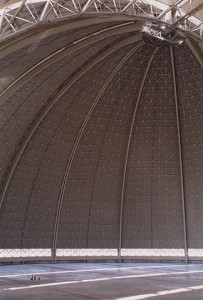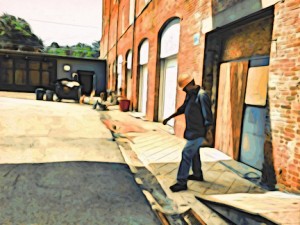I’ve never really been a fan of videogames. I don’t hate them, by any means, or even think they’re a waste of time—I figure they’ve got to be about on par with TV there. I just never got into them. Played a couple arcade machines back in the day, just bought the grandkids a new system for Christmas, but never really got into them myself.
Over the past couple of years, though, a new gadget has popped up I find pretty interesting. It’s called the Oculus Rift, and it’s a virtual reality headset.
I’ve always been intrigued by virtual reality as an idea. It would be incredibly useful for 3D modeling, among other things, not just for videogames. In the real world, though, it has been plagued with problems for decades, ranging from disorienting motion blur to extremely poor graphics to nausea and even vomiting. Most of the problems were caused by technology simply not yet being there, of course, but many of them were also matters of design philosophy.
Here’s a good comparison: making a map isn’t as easy as you’d think. You can’t just cut the surface off of a globe and plaster it on a piece of paper. In order to get it to lay flat, you’d need to cut it or stretch it somehow. By laying flat, of course, I mean showing a halfway accurate image as well. If you cut it, you end up with one of those maps that looks like a sliced up orange peel. It’ll be accurate, but ugly and hard to read.
If you stretch it out, instead, you end up having a hundred different new problems to solve. Your continents are going to be seriously distorted For example, Africa and Greenland (yep, I know: Greenland isn’t technically a continent) usually get much of the brunt of this. Africa, notably, is usually presented about the size of South America, when it actually dwarfs South America.
I won’t go into too many technical details that I’d likely hash up. The Oculus Rift is, after all, a gaming device, which is not my subject of expertise. Still, the creators are essentially going about creating the Rift with a design philosophy that is very different than what’s come before. Instead of just putting a 3D view right in front of you and calling it a day, they’ve actually designed the screens inside the goggles to replicate actual human fields of view.
They’ve included motion sensors capable of allowing you to look around in a realistic way. So to finish the comparison, they’re not just trying to plaster the skin of the globe on a sheet of paper; they’re actually trying to make it fit. Actually, I guess it’s sorta the opposite of that, they’re trying to take a map and refit it around the globe again, and…
Well, never mind. You get the idea, right? It makes sense to me, at least.

 Unfortunately, it sometimes isn’t possible to construct a shallow ramp, usually due to terrain. You’ve still got to be able to get up to the top, though, which is where funiculars come into the picture.
Unfortunately, it sometimes isn’t possible to construct a shallow ramp, usually due to terrain. You’ve still got to be able to get up to the top, though, which is where funiculars come into the picture. Depending on the amount of space available, the carts might have separate tracks, or they may share tracks. When they share track, there’s generally a split rail in the middle of the run that diverts the carts around each other.
Depending on the amount of space available, the carts might have separate tracks, or they may share tracks. When they share track, there’s generally a split rail in the middle of the run that diverts the carts around each other. The first use was actually pre-medieval, though it was used on occasion in medieval times. Siege ramps are huge earthen ramps built right up a castle or city wall, a cliff face, or other positions of strength. They’re about as absurd as you’d think: the builders are going to come under constant attack by the people above, resulting in a wasteful loss of life. It was really only used when the besiegers grossly outnumbered the besieged, were otherwise unable to break through the enemy defenses, and had little care for loss of life on their side. The Romans used it a few times, as did a few of the smaller empires before them, and a few of the smaller kingdoms they conquered.
The first use was actually pre-medieval, though it was used on occasion in medieval times. Siege ramps are huge earthen ramps built right up a castle or city wall, a cliff face, or other positions of strength. They’re about as absurd as you’d think: the builders are going to come under constant attack by the people above, resulting in a wasteful loss of life. It was really only used when the besiegers grossly outnumbered the besieged, were otherwise unable to break through the enemy defenses, and had little care for loss of life on their side. The Romans used it a few times, as did a few of the smaller empires before them, and a few of the smaller kingdoms they conquered. The other use was in siege towers. These, at least, were constructed with a bit more safety in mind for the troops on your side: not that sending them over an enemy castle wall is, particularly, a safer idea. Siege towers, depending on the whim of the builder, were generally a bizarre hybrid of ramp, staircase, ladder, and watchtower, all built out of wood and canvas and stuck on wheels to roll right up to the castle walls, where troops could exit the tower directly onto those walls.
The other use was in siege towers. These, at least, were constructed with a bit more safety in mind for the troops on your side: not that sending them over an enemy castle wall is, particularly, a safer idea. Siege towers, depending on the whim of the builder, were generally a bizarre hybrid of ramp, staircase, ladder, and watchtower, all built out of wood and canvas and stuck on wheels to roll right up to the castle walls, where troops could exit the tower directly onto those walls. The ancient Greeks recognized three simple machines to start with: the lever, the screw, and the pulley. The man who came up with the idea, Archimedes, was a brilliant but crazy guy. Built crazy ancient super weapons to sink entire enemy fleets one day, then jury rigged an ancient precursor to calculus the next. He’s considered one of the greatest mathematicians of all time for a good reason. He’s the kind of dude who could have moved the world, if you gave him a long-enough lever.
The ancient Greeks recognized three simple machines to start with: the lever, the screw, and the pulley. The man who came up with the idea, Archimedes, was a brilliant but crazy guy. Built crazy ancient super weapons to sink entire enemy fleets one day, then jury rigged an ancient precursor to calculus the next. He’s considered one of the greatest mathematicians of all time for a good reason. He’s the kind of dude who could have moved the world, if you gave him a long-enough lever. After Simon Steven completed the simple machine sextet, of course, the development of the science behind simple machines hardly stopped. Galileo Galilei, notably, was the first to figure out that they didn’t create energy but merely transformed it. Leonardo da Vinci also made some critical discoveries regarding calculating friction in simple machines; then he promptly left them unpublished in his notebooks. It took almost two hundred years for someone else to independently rediscover them.
After Simon Steven completed the simple machine sextet, of course, the development of the science behind simple machines hardly stopped. Galileo Galilei, notably, was the first to figure out that they didn’t create energy but merely transformed it. Leonardo da Vinci also made some critical discoveries regarding calculating friction in simple machines; then he promptly left them unpublished in his notebooks. It took almost two hundred years for someone else to independently rediscover them.